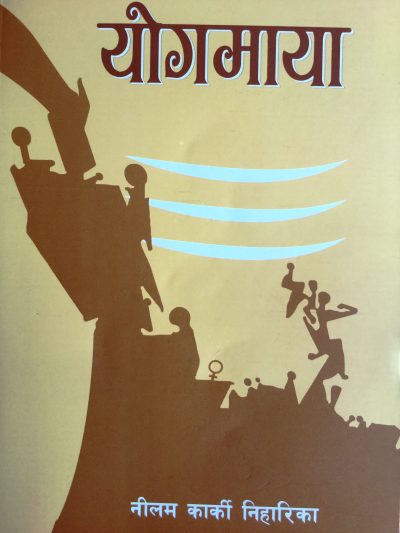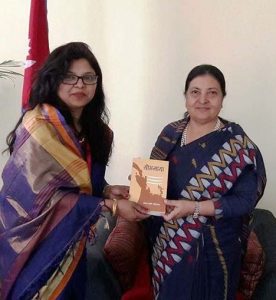The Himalayas: Literature Can Displace Anthropology

Note to readers: please click the share buttons above
Featured image: Cover of the novel Yogamaya
When I was well into my career as an anthropologist specializing in Himalayan peoples, I came across an historical episode concerning two no-longer living but obviously brilliant women who had performed remarkable political feats in the early 20th century. I undertook to uncover their stories, determined first because, inspired by feminist revelations, I myself was in search of women heroes, and second because I had had enough of anthropology’s imperialist claims of scientific impartiality. This meant my breaking from both traditional research methodologies and from academic writing conventions.
I’d been a social anthropologist (ethnographer, of the British School) relying on intensive interviews, and, as we claimed, ‘objective participation observation’. (Ethnography is in fact more akin to journalism than academics will acknowledge.)
Since my subjects were no longer alive I could not apply face-to-face interviews or behavioral observation– the women were already becoming mythical characters– and the few people alive who’d known them were quite elderly. Moreover, those leaders had been political activists at a time when criticism of Nepal’s monarch, its officials and the powerful Hindu priest class was prohibited; any resurgence of interest would be stifled for another decade after my arrival at the site of the early protests.
Those women’s fantastic careers happened on the steamy shore of the roaring Arun Kola deep in the Himalayas. It was possible to imagine past glories there, however isolated and overlooked it now seemed. So I pressed on determinedly.
I was dealing with individuals wildly unrepresentative of their culture. Both were outrageous, atypical characters. A sociological approach was out of the question. And, although the women died only four decades earlier, there was no written record I could find, not initially. My determination proved rewarding because at the time (1980-85) I was welcomed by a small community of ascetics, all women, who’d known both of those radicals. Now quite elderly, they felt impervious to any government retaliation for assisting me.
These ladies enthusiastically spoke about Shakti Yogmaya and Durga Devi—the first a revolutionary, the second a reformer– who they‘d once followed. Recluses, now in their 70s and 80s, they vividly remembered how fifty and sixty years earlier, they’d been filled with fervor and faith in social reform.
Based on their accounts I managed two academic reports. But these stories needed a more creative approach; I began my first attempts at biography. I was aided by the contemporary Nepali poet Parijat who introduced me to the perilous political sttuggle she herself was engaged in. She and I worked on translating the provocative quadrants of the long dead Shakti Yogmaya which in turn initiated me into Nepal’s political realities.
Nepal was still a dictatorship in the 1980s and attention to events surrounding Yogmaya was risky. A known dissident across Nepal, Parijat was not to be intimidated, and she encouraged me to persist.
My book Heir to a Silent Song appeared 17 years ago, published in English in Kathmandu. That effort propelled me out of the academic world and set me on my career in journalism. Meanwhile more revelations about Yogmaya, the most radical woman Nepal had ever produced, attracted a new generation of capable, dedicated Nepali scholars.
Some historical characters, like this Nepali rebel of the early 20th century, are too wild and unwieldy for normal history to grasp. And today, we have a wonderful example of how literature can overtake and outshine scholarly efforts. Shakti Yogmaya, the subject of the eponymous novel published early this year, has just won The Madan Puraskar, Nepal’s most prestigious prize in literature. It’s authored by the US-based Nepali writer Neelam Niharika who writes in Nepali language and is already known for her ambitious historical novels.
Of course I am thrilled that this novel builds on my and other scholars’ efforts starting almost forty years earlier. (It was a colleague of Niharika at Radio Nepal four years ago, who reading those histories, suggested she turn her creative energy to Yogmaya.)
Niharika had no obligation to remain within the boundaries of our accounts. Yet, she undertook more research. In a recent conversation she explained how she interviewed whomever she could in the very hills where Yogmaya’s political campaign occurred almost a hundred years ago. Not herself from the Arun Rivervalley region, Niharika launched a visit there to know more about where Yogmaya was born. (This, after she’d reached locals through social media and phone, to schedule onsite meetings.) The area is much changed but this novelist still conducted her own fieldwork, using modern communications to her advantage. Not only this; she made a video of her arrival in the area, its ecology, recording conversations with local notables of what they remembered of that history.
The novel “Yogmaya” begins with an imaginary conversation between me and the novelist Parijat, thus emphasizing a line of women who helped shape Niharika’s own historical inquiry.
“Yogamaya”’s recognition by the nation’s highest literary prize rewards not only a skilled young author. The subject itself—a local woman warrior—will gain wider traction, inspiring a following which no amount of scholarly articles might. At a time when Nepal is sodden with questionable gender development projects that dwell on the ‘poor and vulnerable victim’ and where many educated urban women, following western feminists, express hardly more than institutional sympathy for their ‘deprived’ rural sisters, this novel offers a fresh look at what a village woman can do.
Perhaps anthropologists too may learn how to honor the people they study with the creation of quality biographies they deserve.
*
This article was originally published on the author’s webpage: www.radiotahrir.org.
Aziz is a veteran anthropologist and radio journalist, also author of Heir to A Silent Song: Two Rebel Women of Nepal, published by Tribhuvan University, Nepal, and available through Barnes and Noble in the USA. She is a frequent contributor to Global Research and Asia-Pacific Research.


